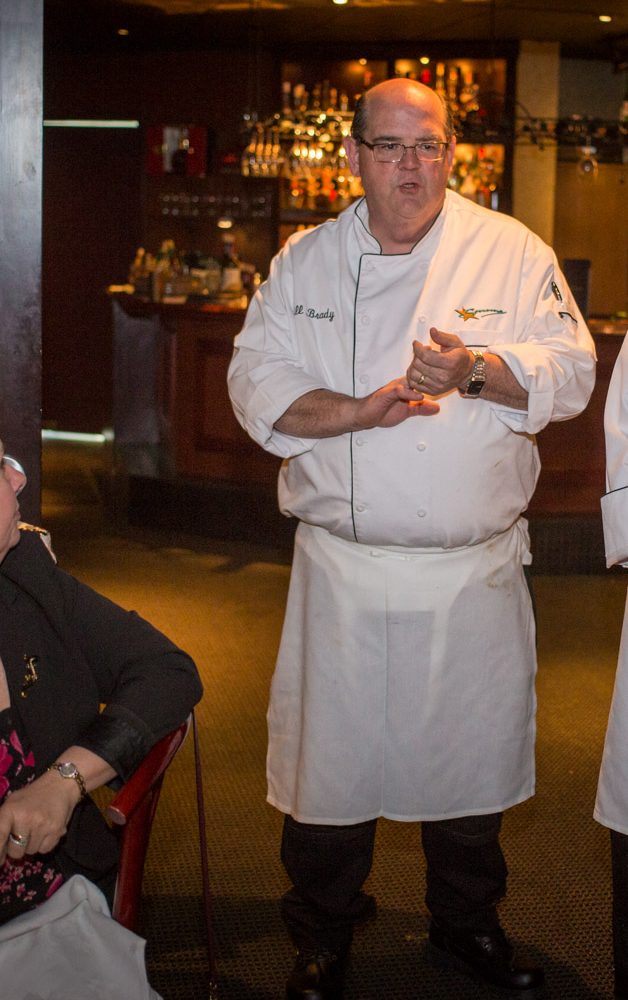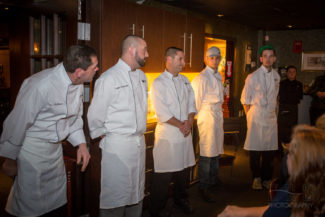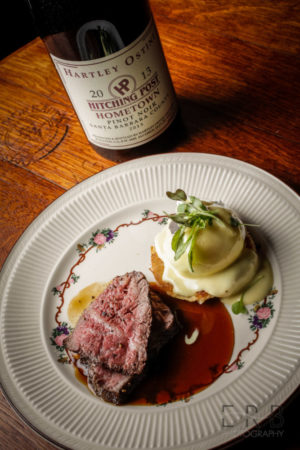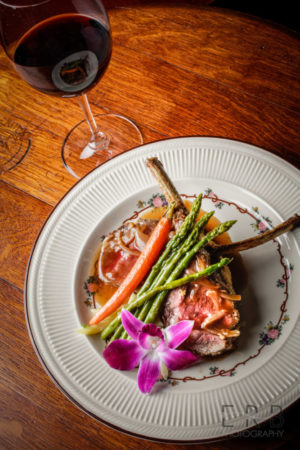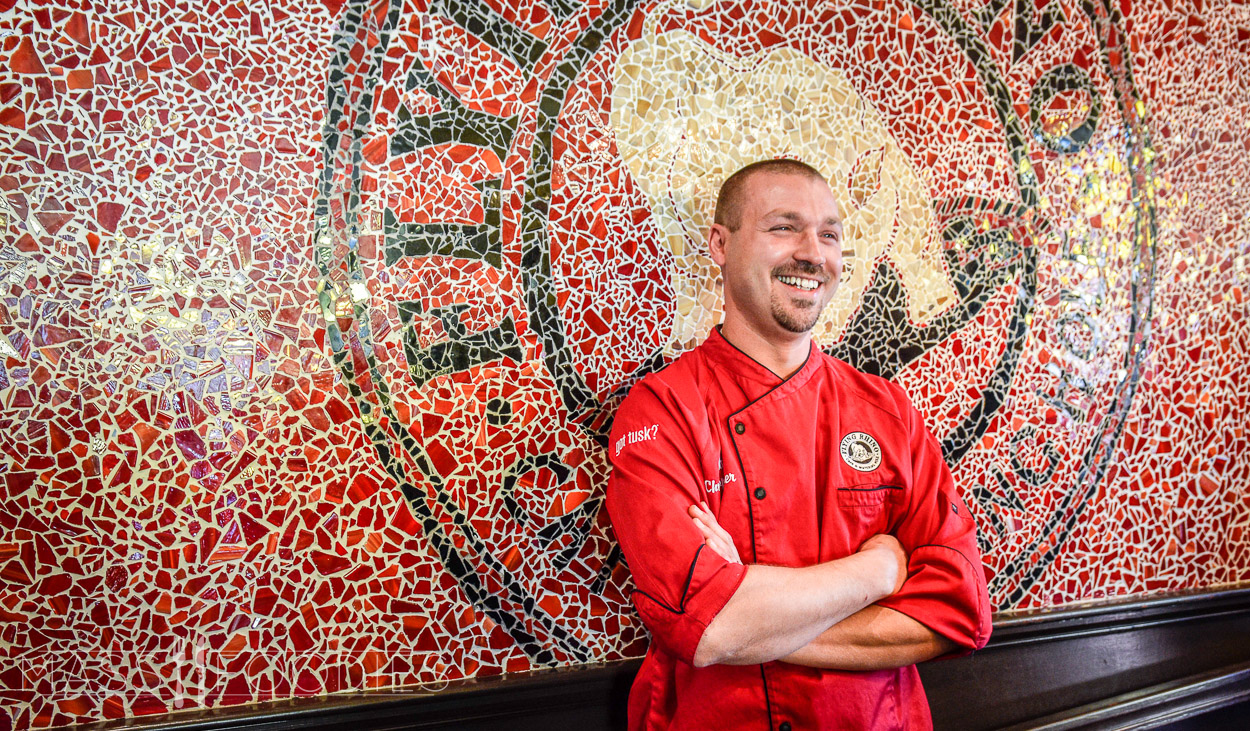
Every chef who has been in the weeds in a kitchen juggles fiery pots and pans. But Christopher O’Harra likes to juggle fire. Literally. This is not just a metaphor for what he has done on so many nights as executive chef at the ever-popular and bustling Flying Rhino Cafe on Shrewsbury Street. Christopher juggles fiery batons outside the kitchen and he has the YouTube evidence to prove it.
That said, it should come as no surprise what Christopher finds the most fun after twenty years in the business.

“Any chef should love the craziness,” he says. “Four hours into crazy pushes where in the third hour you are ready to pull your hair out but it is all going smooth? That is a natural high. You get out of work and you are up for hours because you got crushed for four, five, even twelve hours but all the customers walked out happy and there were no issues? That’s an addicting high and why we are in the business.”
Hearing this Paul Barber, who with his wife Melina have owned and run Flying Rhino since it opened in 2000, smiles, “When he comes out on those days he is pumped. He screams, ‘Yeah.’ [Hulk-style] and asks for a shot of Southern Comfort.”
“If I come out to the bar and ask for a shot of SoCo,” Chris adds, “that’s my end of the night. That’s me being done and happy.”
I have heard similar refrains from chefs before, and I have noticed these chefs often have one thing in common with Christopher: They all started at the bottom of the restaurant ladder washing dishes. They are all also, like Christopher, among the most immensely likable chefs and have the deepest respect for the people who work for them, top to bottom: “If you don’t have respect for your dishwasher or the back room of any kitchen, you don’t have anything,” he says. “You can put out the best food in the world but if you don’t have the pots and pans and people whom you can rely on to get that stuff done? You’re done.”
Sure, Christopher later in his career did some culinary school training in continuing ed at Johnson & Wales. But with his experience, he found himself helping the other students more than he was learning. (He was once told by his instructor after showing a fellow student how to break down a side of fish to, “Get out of here and let me do my job.”) Christopher’s experience started in his hometown of Grafton, where he worked at a small delicatessen. The owner took a liking to him and taught him to make soups and sauces: “Customers would tell me how awesome the soup was or how fantastic this thing I made tasted. That’s where my passion for all this came from. Seeing and hearing people enjoying my food. It didn’t even have to be my recipe.”
Which is good experience to have when you take over an institution like Flying Rhino. The menu may change every six months but many dishes have long histories with guests who expect to enjoy them the way they always have. This doesn’t bother Christopher at all. He finds the same satisfaction at Flying Rhino that he had working that deli counter in Grafton.
First of all, he loves the food and says every week he eats four or more of the Rhino’s signature Ivory Tusk sandwich. (Christopher calls Paul Barber’s chicken-based take on a Philly cheesesteak “the simplest sandwich ever and when made properly fantastic.”)
Second of all, Christopher already knew what he was getting into; he is a boomerang employee: He served as executive sous chef at Flying Rhino for a couple of years starting in 2010. But seeking more normal hours to spend with his wife and their daughter, Alyssa, he got out of the restaurant business and took a corporate dining job with Sodexo. With Monday through Friday daytime hours and no nights and weekends, he could be there for his family.
Today, Christopher calls this professional period of his life, “a slow painful death.”
It wasn’t that it was a bad job, and he liked the people at the company. He also knew what he was getting into: He was a boomerang at Sodexo too, spending seven years there working his way up the ranks to run the corporate dining room at EMC in Hopkinton. But the corporate dining world was no place for a night guy. Those 5:00am starts were “terrible.” And creatively there was just nowhere to go. He realized he could balance family life with the right restaurant opportunity, and when Paul and Melina called and asked him to come back and run the kitchen, he jumped at the chance.
And even faced with a menu filled with staples, Flying Rhino does offer Christopher plenty of opportunities to play.
Case in point the People’s Choice Sticky Pork, so named because it took the People’s Choice Award at the 2015 Worcester Best Chef Competition: A shoulder cut down to fillets, slow braised in an intricate hoisin-based sauce with lots of citrus, given a little bit of heat from jalapeños, and then seared crispy and basted again until it gets a sticky glaze. In the original dish, the pork came with a zucchini pappardelle tossed with a sweet potato purée that Christopher thought would make a great sauce when spiked with a little wasabi. The most recent incarnation swaps chipotle for the wasabi – Asian with a Southwestern flair, which pretty much sums up Christopher’s approach to cooking: “As long as the flavors work for me that’s what makes me happy.”
The dish has also made customers happy and has stayed on the menu since it was introduced after the competition, something Christopher takes great pride in. Part of the dish even found new life on the latest menu. Finding himself with the need for a daily feature and a ton of that purée left over, he decided to throw it into some risotto and scallops and see what happened. The result was the Sweet Heat Scallops. An arugula and candied bacon salad dressed with bacon fat comes on the side. As he says, “How is that not good?”
But Christopher is quick to point out that while he takes responsibility for everything that comes out of his kitchen, the regular and featured menu items take a team effort in the kitchen to make them work “The Rhino Way.” For example, the “Number 3” grilled Korean barbeque beef short ribs were inspired by a Korean sous chef. The Zen Rice Bowl was inspired by a dish Melina had on a visit to Colorado. But inspiration is where the work begins: “We will take inspiration from anyone in the kitchen, and if we like it, we will try it ten times until we decide exactly what do with it. That’s how the dishes are born here,” Christopher says.
Inspiration can even come from the Rhino’s past: Case in point, the “Mushroomtopia.” Paul and Melina had requested the dish from the past be put back on the menu for the summer, but the original did not say summer to Christopher. So, he recreated it as a pan seared wild mushroom ravioli with pesto brown butter, asparagus, caramelized mushroom, and fresh tomatoes – a seasonal vegetarian dish that could easily be made meaty at the customer’s request.
And if there are some limits for Christopher’s creative impulses? He is still stretching his skills by learning the front of the house from Paul. That’s also where you’ll find the light of Christopher’s life, his daughter Alyssa, on the days she comes in. Despite an adorable picture of her picking parsley in the kitchen on the home screen of his phone, Alyssa prefers working with the bartender or checking in on tables in her apron and “Tusk” shirt.
“She loves coming in here,” Christopher says. And while he says he does it all for her, he knows he couldn’t do what he does without the love and support of his wife, Kelly. “She does it all. She allows me to do this 60 hours a week. I don’t even cook at home. She does.”
Clearly, whether at home or away, love or life, for Christopher O’Harra it all comes down to having the best team by his side.

